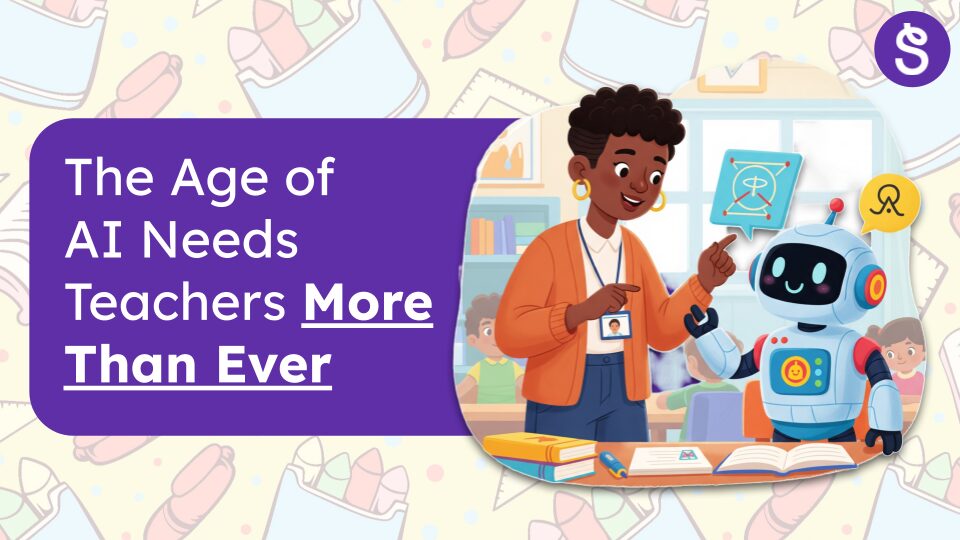Thoughts written from Sara Romero-Heaps Seesaw Connect Keynote
Artificial intelligence is everywhere, including classroom, but AI tools that amplify teaching are most effective when guided by educators.. Educators are tuned into how this will impact education. Families are concerned about how this will impact their children. These are real, valid feelings.. There’s no shortage of headlines declaring that AI will replace teachers. Some media sources push back saying teachers are irreplaceable because of the human relationships they foster. Here’s the truth: both are right, and both fall short.
AI is not replacing teachers—it’s amplifying them
AI can support and even amplify great teaching. But only when teachers are in the driver’s seat. Their judgment, creativity, and expertise must remain at the forefront.
AI should take some tasks off teachers’ plates. Using teacher-led AI in elementary schools for grading or generating practice problems can free time for meaningful instruction. Freeing educators from these tasks opens up space for what really matters: connection, creativity, and insight.
But while AI can generate prompts or analyze fluency, it cannot replace the human wisdom that drives learning. It can’t feel the hesitation in a child’s voice. It can’t know when to push and when to pause. It can’t read how a room shifts during a lesson. It can’t design with empathy or lead with equity. And it doesn’t know your students.
That’s why the question isn’t if teachers have a place in the age of AI. The question is, “How do we elevate the teacher’s role so students truly benefit from what AI has to offer?”.
The new (and familiar) roles of educators in the age of AI
If we’re going to get this right, we need to reframe the conversation around human-centered AI in classrooms. Teachers are not just ‘relationship builders’. They are intellectual leaders in the classroom. As AI takes shape in education, here are five roles I believe teachers must own:
1. The Curator: Turning Content into Meaning
AI can generate an endless stream of lesson plans, examples, and resources. But it’s the teacher who chooses what’s relevant, developmentally appropriate, and aligned to student needs.
Example: An educator asks AI for storytelling activities that build empathy. The tool delivers 12 options. The teacher selects stories relevant to her students’ cultural backgrounds and adds local community narratives to deepen the connection.
Why it matters: In a world of infinite content, selection is pedagogy. Teachers curate experiences that are developmentally appropriate and aligned with student needs to help deepen engagement, not just provide information. AI generates content. The teacher curates meaning.
2. The Orchestrator: Designing for Real-Time Learning
Orchestration isn’t reactive; it’s responsive, strategic, and grounded in deep expertise. AI builds the outline. The teacher choreographs the experience—a symphony of data, energy, and emotion. AI can provide structure, but it’s the teacher who choreographs the moment.
Example: It’s been raining all week. Kids are stir-crazy. A teacher ditches the AI- suggested video and sends students on a “walk and talk” outside to discuss habitats. The same standards, but more movement, more joy.
Why it matters: Learning happens in context. Only teachers can read the room and adapt in real time.
3. The Ethicist: Protecting What Matters
AI is powerful, but it isn’t neutral. Teachers must question how tools are used and who they serve or potentially harm.
Example: A teacher reviews auto-graded writing and notices tone-based feedback from AI disproportionately affects students of color. She rewrites the prompt to focus on creativity and contacts the developers of the auto-grading system to report the bias. Where AI moves fast, the teacher moves with wisdom. They ask: Is this fair? Is it appropriate? Who might be harmed?
Why it matters: Teachers are the moral compass of the classroom. They uphold dignity, fairness, and care…especially when tech can’t.
4. The Connector: Making Learning Personal
Teachers bridge curriculum with identity. They make learning real. Anchored in place, community, and culture.
Example: The teacher takes an AI-developed unit on climate change and personalizes it with stories of Indigenous land stewardship and a visit from a local environmental leader. The result? Relevance, pride, and belonging. Teachers go beyond the generic to make learning personal and motivating, tying curriculum to students’ lives, cultures, communities, and identities so that every child feels seen and valued. AI offers the shell. The teacher brings it to life.
Why it matters: Students learn best when they see themselves in the story. Teachers make that possible because they know their students deeply and can make these connections. When students feel they belong, engagement and achievement rise.
5. The Architect of Relationships and Joy
Let’s not forget: connection is cognition. Emotion drives learning. In a world of personalized pathways, teachers build the community that sustains growth.
Example: AI data shows the teacher that two students (who are not normally paired together and are at different reading levels) are both writing about bravery. The teacher uses this opportunity to pair them for an “author chat” to share personal stories and provides some prompts to get the conversation started.. A moment of vulnerability becomes a bridge with human connection. Why it matters: Teachers craft environments where joy, safety, and human connection fuel learning because emotion isn’t separate from cognition; it’s essential to it.
AI can align tasks. But only a teacher can create a sense of community and shared belonging.
We are better together
Teachers are already doing this work in classrooms every day. But as AI becomes more present in our tools, our curriculum, and our decisions, we have a choice: we can let it reshape education for us—or we can shape it ourselves.
AI needs teachers’ insights, boundaries, and brilliance.
The role of the teacher hasn’t diminished—it’s been elevated.
In the age of AI, we must rely on teachers’ uniquely human expertise even more, because our students deserve nothing less.








